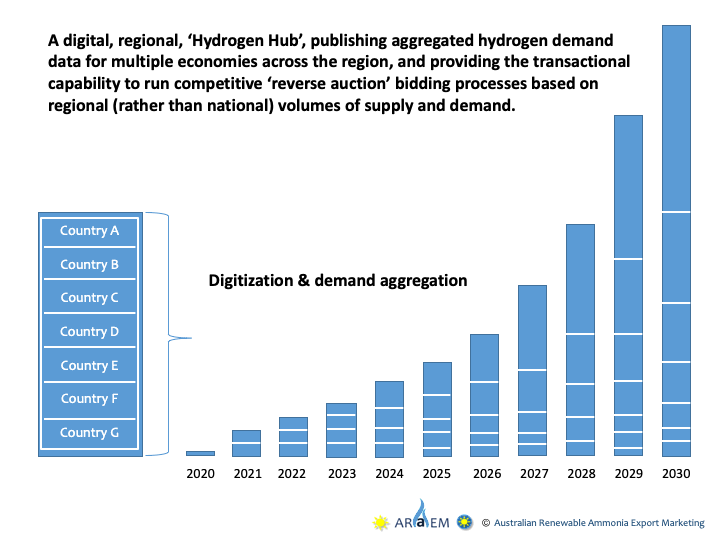Renewable hydrogen could fuel Australia's next export boom after CSIRO breakthrough
Australia's next big export industry could be its sunlight and wind, as game-changing technology makes it easier to transport and deliver their energy as hydrogen.
Industry players are even talking up renewable hydrogen as the next liquefied natural gas (LNG) industry, which could supply hydrogen to power cars, buses, trucks and trains in Japan, South Korea and even Europe.
Their plans have been given a boost by a CSIRO-developed metal membrane, which allows the high-purity hydrogen, needed for hydrogen-powered cars, to be separated from ammonia.
What is renewable hydrogen?
Hydrogen is a carrier of energy
Renewable hydrogen is produced by purifying seawater, then separating the hydrogen and oxygen via electrolysis
The process of separation is powered by solar or wind energy
The hydrogen becomes a vehicle for storing renewable energy such as solar or wind
It is converted into transportable forms for export
CSIRO principal research scientist Michael Dolan said the technology, now being trialled on an industrial scale in Australia, was "the missing link" that allowed hydrogen to be transported and used as an energy source.
"One of the great problems with hydrogen is that it's difficult to transport over long distances because it has such a low density," he told ABC News.
"Ammonia is a very nice way of transporting hydrogen from point A to point B — be it from Australia to Japan, for example — because it actually has a higher hydrogen density than liquid hydrogen."
The technology the CSIRO has developed can then be applied at the point of use, converting ammonia back into hydrogen for use in transport fleets.
Dr Dolan said the technology had the potential to turn Australia into a renewable energy superpower.
"Hydrogen is the ultimate clean fuel. The only emission arising in the use of hydrogen is water. You can also manufacturer hydrogen completely renewably," he said.
While there are only four hydrogen cars in Australia — produced by Hyundai and Toyota — South Korea already has hydrogen-powered taxis on its streets.
"There's potentially a very big market for the technology, given these cars are starting to get onto the road in pretty big numbers in Asia and Europe," Dr Dolan said.
In Japan, the 2020 Tokyo Olympics will be a showcase of its dream of becoming a "hydrogen society", as it shifts away from nuclear power after the Fukushima disaster.
While a long way behind these countries, Australian governments are beginning to actively embrace the potential of hydrogen as a clean alternative fuel source — and export industry.
INFOGRAPHIC: How renewable hydrogen is produced. (Supplied: Renewable Hydrogen)
South Australia, for example, is looking to invest in hydrogen projects via a $150 million clean energy fund as it tries to secure its energy supplies.
The ACT Government announced last year it would spend $180 million on hydrogen projects, including a fleet of cars and a refuelling station.
It comes as the Australian Renewable Energy Agency recently made the exporting of renewable energy such as hydrogen one of its top priorities for $800 million of investment.
Companies line up for hydrogen
One of the key players in the industry is Andrew Want, the managing director of Renewable Hydrogen — a company involved in projects in New South Wales, South Australia and Western Australia.
Describing the industry as bottling and shipping sunlight on an industrial scale, Mr Want said renewable hydrogen was at a similar stage as LNG in the 1970s, when technology allowed natural gas to be liquefied and transported.
"We genuinely have another LNG industry on our hands, exporting energy," he said.
Mr Want said a renewable hydrogen export industry was nearing commercial viability, with the CSIRO technology an important development.
"What the CSIRO technology is on the cusp of achieving is using renewable ammonia as a very efficient way to transport hydrogen — and that's a game-changer," he said.
"It means Korea, Japan, the whole of South-East Asia can now import Australian renewable energy in the form of renewable hydrogen.
"Using the CSIRO technology, they can 'crack' the hydrogen back out and run transport vehicles on it, zero carbon."
One company investigating the potential is Norwegian company Yara, which exports ammonia from its production plant in WA's Pilbara.
Yara is working towards a trial involving a 2.5MW solar array to power its electrolysis process, with the possibility of eventually fuelling its entire operations using the region's abundant sunlight.
The local Mayor, Peter Long from the City of Karratha, is a champion of the industry in a region well-placed to capitalise on its abundant sunlight, export facilities and gas infrastructure.
"It's totally renewable, [could provide] jobs forever and we can actually export the hydrogen gas overseas to Japan," he said.
Tomorrow's "hydrogen society" may still be a dream — but the Pilbara and Australia appear to be well-placed to play a key role.
http://www.abc.net.au/news/2017-05-11/hydrogen-breakthrough-could-fuel-renewable-energy-export-boom/8518916





